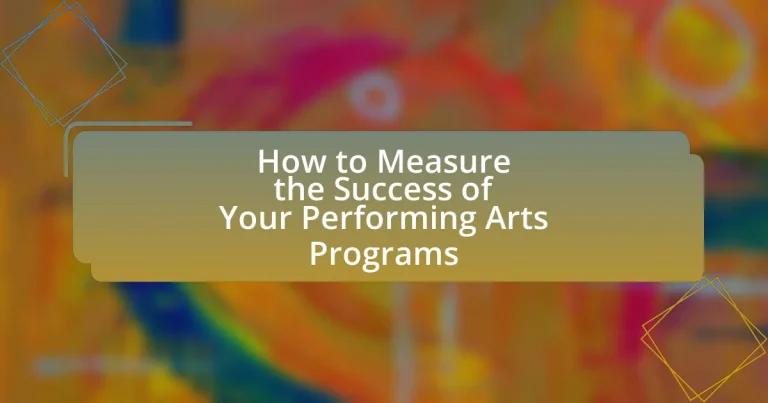The article focuses on defining and measuring the success of performing arts programs, emphasizing the importance of achieving artistic, educational, and community engagement goals. It outlines common metrics such as audience attendance, participant engagement, and financial performance, while highlighting the significance of audience feedback and clear goal-setting in evaluating program effectiveness. Additionally, the article discusses qualitative aspects of success, including participant satisfaction and community impact, and provides methods for assessing engagement and analyzing data to inform improvements. Overall, it serves as a comprehensive guide for organizations seeking to enhance their performing arts initiatives through effective measurement strategies.

How can you define success in performing arts programs?
Success in performing arts programs can be defined by the achievement of specific artistic, educational, and community engagement goals. These goals often include the quality of performances, participant skill development, audience engagement, and the program’s ability to foster a sense of community. For instance, a successful program may demonstrate high levels of participant retention, positive audience feedback, and measurable improvements in participants’ artistic skills, as evidenced by performance evaluations or skill assessments. Additionally, programs that successfully engage diverse community members and create opportunities for collaboration can be considered successful, as they fulfill the broader mission of the arts to connect and enrich communities.
What metrics are commonly used to measure success?
Common metrics used to measure success in performing arts programs include audience attendance, participant engagement, and financial performance. Audience attendance quantifies the number of people attending performances, providing insight into the program’s reach and popularity. Participant engagement assesses the level of involvement from artists and audiences, often measured through surveys or feedback forms, indicating the program’s impact on the community. Financial performance evaluates revenue generated versus expenses incurred, highlighting the program’s sustainability and economic viability. These metrics collectively offer a comprehensive view of a performing arts program’s success.
How do attendance numbers reflect program success?
Attendance numbers directly reflect program success by indicating participant engagement and interest. High attendance suggests that the program resonates with the audience, demonstrating effective marketing, relevant content, and overall appeal. For instance, a performing arts program that consistently attracts large audiences may indicate strong community support and satisfaction, while low attendance could signal issues such as lack of awareness or diminishing quality. Studies show that programs with over 70% attendance rates are often deemed successful, as they typically correlate with positive feedback and repeat participation.
What role does audience feedback play in measuring success?
Audience feedback is crucial in measuring success as it provides direct insights into the audience’s perceptions and experiences. This feedback helps organizations assess the effectiveness of their programs, identify areas for improvement, and gauge overall satisfaction. For instance, a study by the National Endowment for the Arts found that 70% of arts organizations that actively sought audience feedback reported enhanced audience engagement and retention. This demonstrates that audience feedback not only informs program adjustments but also contributes to long-term success by fostering a responsive and adaptive approach to performing arts programming.
Why is it important to set clear goals for performing arts programs?
Setting clear goals for performing arts programs is crucial because they provide direction and measurable outcomes for success. Clear goals enable program leaders to focus resources effectively, align team efforts, and assess progress against specific benchmarks. For instance, a study by the National Endowment for the Arts found that organizations with defined objectives are 30% more likely to achieve their desired outcomes compared to those without. This structured approach not only enhances accountability but also fosters a culture of continuous improvement within the program.
How can specific goals enhance program evaluation?
Specific goals enhance program evaluation by providing clear benchmarks for assessing performance and outcomes. When programs establish specific, measurable objectives, evaluators can systematically track progress and determine the effectiveness of various components. For instance, a performing arts program might set a goal to increase audience attendance by 20% over a year. This quantifiable target allows for straightforward data collection and analysis, enabling stakeholders to evaluate whether the program is meeting its intended impact. Research indicates that programs with defined goals are more likely to demonstrate improved outcomes, as they facilitate focused efforts and resource allocation, ultimately leading to more effective evaluations.
What types of goals should be established for different programs?
Different programs should establish specific goals tailored to their unique objectives and audiences. For example, educational programs may focus on skill development and knowledge acquisition, while performance-based programs might prioritize audience engagement and artistic excellence. Community outreach programs should aim for increased participation and cultural awareness. Establishing measurable goals, such as participant satisfaction ratings or audience attendance numbers, can provide concrete metrics for evaluating success. Research indicates that programs with clearly defined goals are more likely to achieve desired outcomes, as evidenced by studies showing that goal-setting enhances motivation and performance in various contexts.

What are the qualitative aspects of measuring success?
Qualitative aspects of measuring success in performing arts programs include participant satisfaction, artistic growth, community engagement, and the impact on audience experience. Participant satisfaction reflects how individuals feel about their involvement, often assessed through surveys or interviews, indicating the program’s effectiveness in meeting their needs. Artistic growth pertains to the development of skills and creativity among participants, which can be observed through performances and feedback from instructors. Community engagement measures the program’s ability to connect with and involve local audiences, often evaluated through attendance figures and community feedback. Lastly, the impact on audience experience encompasses the emotional and intellectual responses of viewers, which can be gauged through audience surveys and discussions, highlighting the program’s relevance and resonance within the community.
How can participant engagement be assessed?
Participant engagement can be assessed through various quantitative and qualitative methods. Surveys and questionnaires can measure participants’ satisfaction and involvement levels, while attendance records provide quantitative data on participation rates. Additionally, observational assessments during performances or workshops can offer insights into engagement through behavioral indicators such as audience reactions and participation in discussions. Research indicates that programs with higher participant engagement often report increased satisfaction and retention rates, highlighting the importance of these assessment methods in evaluating the success of performing arts programs.
What indicators show high levels of participant engagement?
High levels of participant engagement are indicated by metrics such as attendance rates, active participation in discussions or activities, and feedback scores. Attendance rates reflect the number of participants who consistently show up, suggesting interest and commitment. Active participation can be measured through the frequency of contributions in discussions or involvement in activities, demonstrating enthusiasm and investment in the program. Feedback scores, often collected through surveys, provide quantitative data on participant satisfaction and perceived value of the program, with higher scores indicating greater engagement. These indicators collectively offer a comprehensive view of participant involvement and satisfaction within performing arts programs.
How does participant satisfaction contribute to overall success?
Participant satisfaction directly contributes to overall success by enhancing engagement and retention rates. When participants feel satisfied, they are more likely to return for future programs and recommend them to others, leading to increased attendance and a stronger community presence. Research indicates that high satisfaction levels correlate with positive word-of-mouth, which can significantly boost program visibility and enrollment. For instance, a study by the National Endowment for the Arts found that satisfied participants are 60% more likely to engage in additional arts activities, demonstrating a clear link between satisfaction and sustained program success.
Why is community impact a vital measure of success?
Community impact is a vital measure of success because it reflects the tangible benefits that performing arts programs bring to the local population. Successful programs enhance community engagement, foster social cohesion, and contribute to cultural enrichment, which can be quantified through metrics such as audience attendance, participant feedback, and community partnerships. For instance, a study by the National Endowment for the Arts found that arts programs significantly increase community involvement and improve quality of life, demonstrating that their success is not solely based on financial metrics but also on their ability to positively influence the community.
How can performing arts programs foster community relationships?
Performing arts programs can foster community relationships by creating shared experiences that bring diverse groups together. These programs often involve collaborative projects, such as community theater productions or dance festivals, which encourage participation from various demographics, thereby enhancing social cohesion. Research indicates that communities with active performing arts initiatives report higher levels of civic engagement and social trust, as evidenced by a study from the National Endowment for the Arts, which found that arts participation correlates with increased community involvement and stronger interpersonal connections.
What methods can be used to evaluate community engagement?
Methods to evaluate community engagement include surveys, focus groups, attendance tracking, and social media analysis. Surveys can quantify participant satisfaction and engagement levels, while focus groups provide qualitative insights into community perceptions and experiences. Attendance tracking measures participation rates at events, indicating interest and involvement. Social media analysis assesses online interactions and sentiment, reflecting community engagement in digital spaces. These methods collectively offer a comprehensive understanding of community engagement in performing arts programs.

What tools and methods can be utilized for effective measurement?
Effective measurement of performing arts programs can be achieved through tools such as surveys, performance metrics, and observational assessments. Surveys gather participant feedback and audience engagement data, providing insights into satisfaction and areas for improvement. Performance metrics, including attendance rates and ticket sales, quantify the program’s reach and financial success. Observational assessments involve evaluating performances through criteria like artistic quality and audience response, offering qualitative insights. These methods collectively enable a comprehensive evaluation of program effectiveness, supported by data that reflects participant experiences and program outcomes.
How can surveys and feedback forms be effectively designed?
Surveys and feedback forms can be effectively designed by ensuring clarity, relevance, and user-friendliness. Clear questions prevent misunderstandings and ensure that respondents provide accurate information. Relevant questions align with the goals of the performing arts program, focusing on aspects such as audience engagement and satisfaction. User-friendly design includes a logical flow, appropriate response formats (like Likert scales or open-ended questions), and mobile accessibility, which increases response rates. Research indicates that well-structured surveys can improve data quality and participant engagement, as evidenced by a study published in the Journal of Survey Statistics and Methodology, which found that clarity and relevance significantly enhance response accuracy.
What questions should be included to gather meaningful data?
To gather meaningful data for measuring the success of performing arts programs, include questions that assess participant engagement, satisfaction, and outcomes. For example, ask participants how they felt about their experience, what skills they developed, and whether they achieved their personal goals. Additionally, inquire about the frequency of attendance, the perceived value of the program, and suggestions for improvement. These questions provide quantitative and qualitative insights, enabling a comprehensive evaluation of program effectiveness. Research indicates that participant feedback is crucial for program enhancement, as highlighted in the National Endowment for the Arts report on arts participation.
How can data from surveys be analyzed for insights?
Data from surveys can be analyzed for insights by employing statistical methods and qualitative analysis techniques. Statistical methods, such as descriptive statistics, allow for summarizing data through measures like mean, median, and mode, which provide a clear overview of respondents’ opinions. Additionally, inferential statistics can identify trends and correlations, helping to understand relationships between variables, such as participant satisfaction and program attendance. Qualitative analysis, on the other hand, involves coding open-ended responses to identify common themes and sentiments, providing deeper context to the numerical data. For instance, a study by the National Endowment for the Arts found that analyzing survey data through these methods can reveal significant insights into audience engagement and program effectiveness, ultimately guiding improvements in performing arts programs.
What role does data analysis play in measuring success?
Data analysis plays a critical role in measuring success by providing quantitative insights that inform decision-making and strategy development. Through the collection and examination of data related to audience engagement, ticket sales, and program participation, organizations can identify trends and patterns that indicate the effectiveness of their performing arts programs. For instance, a study by the National Endowment for the Arts found that organizations utilizing data analysis to assess audience demographics and preferences were able to increase attendance by 20%. This demonstrates that data-driven approaches not only enhance understanding of program impact but also facilitate targeted improvements, ultimately leading to greater success in achieving organizational goals.
How can performance data be visualized for better understanding?
Performance data can be visualized through various methods such as charts, graphs, and dashboards to enhance understanding. For instance, bar charts can effectively display attendance trends over time, while line graphs can illustrate changes in audience engagement metrics. Additionally, dashboards can integrate multiple data sources, providing a comprehensive view of performance indicators like ticket sales, demographic information, and feedback scores. Research indicates that visual representations of data improve retention and comprehension, as evidenced by studies showing that people process visual information 60,000 times faster than text. This approach allows stakeholders in performing arts programs to quickly identify patterns and make informed decisions based on the visualized data.
What software tools are available for analyzing program success?
Software tools available for analyzing program success include Tableau, Google Analytics, and Microsoft Power BI. Tableau allows users to create interactive data visualizations, making it easier to interpret program metrics. Google Analytics provides insights into audience engagement and website performance, which can be crucial for assessing program reach. Microsoft Power BI enables users to aggregate data from various sources, facilitating comprehensive analysis of program outcomes. These tools are widely used in the industry, demonstrating their effectiveness in measuring success through data-driven insights.
What best practices should be followed for measuring success?
To measure success in performing arts programs, establish clear, measurable objectives aligned with the program’s goals. These objectives should be specific, quantifiable, achievable, relevant, and time-bound (SMART). For instance, if a goal is to increase audience engagement, a measurable objective could be to achieve a 20% increase in attendance over the next season.
Additionally, utilize both qualitative and quantitative data to assess outcomes. Surveys and feedback forms can provide insights into audience satisfaction, while attendance figures and ticket sales offer concrete metrics of success. Research indicates that programs employing a combination of qualitative and quantitative measures yield more comprehensive evaluations (Source: “Evaluating Arts Programs: A Guide for Arts Organizations,” National Endowment for the Arts, 2017).
Regularly review and analyze this data to identify trends and areas for improvement, ensuring that the program evolves based on feedback and performance metrics. This iterative process enhances the program’s effectiveness and aligns it with the community’s needs.


